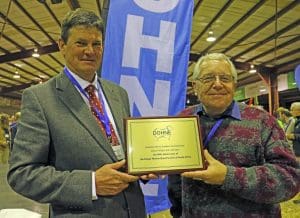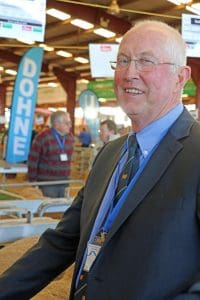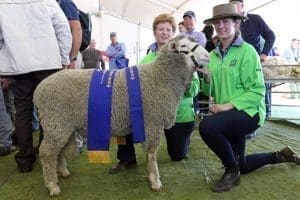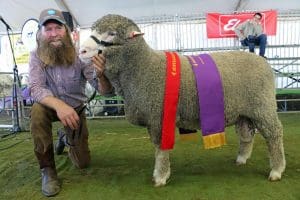
South African Dohne Merino Breed Society president Koos Vosloo and manager Kobus Delport were presented with a plaque by the Australian Dohne Breeders Association commemorating 50 years since formation of the South African body. Picture – Kim Woods.
FUTURE challenges for the Dohne breed lay with combining Dohne and Merino breeding values, increasing the use of genomics and widening the use of non-Dohne genetics.
They were key messages heard by national and international delegates at the inaugural Global Dohne Conference hosted by the Australia Dohne Breeders Association.
The conference at Dubbo on July 21-22 drew 44 international delegates from South Africa, Uruguay, United States and New Zealand, and 139 from five Australian states. It followed the first global showing of Dohne sheep in 40 years at the Australian Sheep and Wool Show in Bendigo.
The conference program included high profile industry speakers, sheep and trade displays, a fashion parade of the Australian Wool International Runway collection, a formal dinner and the National Dohne Ram Sale.
Delegates heard how commercial Australian sheep producers have embraced the Dohne breed. Dohne genetics now influence 20 percent of Australian commercial flock breeding ewes.
Lamb and wool markets driving Dohne evolution

Dohne technical adviser Allan Casey. Picture – Kim Woods.
Australian Dohne Breeders Association technical adviser Allan Casey said the buoyant lamb and wool market had driven evolution of the Dohne in recent times. He said the Dohne had the right balance of wool and meat production for the Australian market.
Australian Dohne Breeders Association president Richard Beggs described the inaugural global conference as a “milestone event’’. The conference was also a celebration of 50 years since the formation of the South African Dohne Breeders Association, he said.
“The Dohne is unique – a passion of wanting to develop a better sheep has what led to the Dohne.
“It ticks all the boxes – we have meat, wool and high fertility.’’
South African Dohne Merino Breed Society president Koos Vosloo said the challenges for the future lay with more complex breeding objectives balanced against the cost to the breeder. Marketing needed to be focused on crossbreeding and international expansion, he said.
“We are a little jealous of Australia as you can export semen and genetics all over the world – South Africa’s veterinary protocols jeopardise the effective exchange of genetic material.”
Dohne Merino ram sales in South Africa have risen from 2438 in 2010 to 2718 in 2015. In Australia, genetic gain since 1998 had been rapid at 30 index points.

Fiona and Isobelle Cameron, Koonik Dohnes, Nurcoung, Victoria, with their junior champion ram at 2016 Australian Sheep and Wool Show, Bendigo. Picture – Kim Woods.
Dohne database manager Brett Wilson said genetic gain had been achieved in post weaning body weight and eye muscle depth. Mr Wilson said clean fleece weight and yearling fibre diameter had been maintained.
“The benchmarking of the breed, even against Merinos, is important. The continued involvement in sire evaluation trials and opportunities to enter teams of wethers in wether trials to test our genetics.”
The breed has moved from the original 50:50 wool and meat index in 1998 to a 70pc wool and 30pc meat focus in 2007. Last year, this was further streamlined to maintain fleece weight and maximize production in meat traits.
The weightings are 56pc on body weight, 34pc on eye muscle area, 8pc on reproduction and 2pc on both fleece weight and fibre diameter.
Dohne breeders embracing genetic tools

Murray Rogerson, Stirling Dohnes, Glenthompson, Victoria, exhibited the reserve grand champion Dohne ram at the Australian Sheep and Wool Show. Picture – Kim Woods.
Mr Casey said the Dohne breed was embracing genetic tools including genomic testing and RamSelect.
He said the evaluation of using non-Dohne genetics (dual-purpose Merino) was one way of progressing the breed.
Commercial breeders thought of the Dohne has both highly productive and selectable, Mr Casey said.
“There is a quality assurance program put in place to allow breeders to be confident about the information.
“We continue to drive the breeding in a dual purpose way – meat, wool and surplus sheep, and we are trying to adjust that breeding to match the current market.’
Source: Kim Woods, Australian Dohne Breeders Association.

Dear Sirs
It is a pleasure to say hello to you. I should be very thankful if you would let me know about a guide to raise Dohne sheep. I live in the Andean Region of Peru and it is of importance for our country to improve sheep raising by introducing sheep like Dohne.
Thank you very much in advance.
Yours faithfully
Mario Attilio Narro